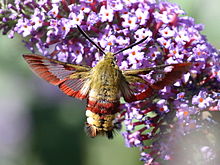Hemaris fuciformis
Appearance
| Hemaris fuciformis | |
|---|---|

| |
| Scientific classification | |
| Domain: | Eukaryota |
| Kingdom: | Animalia |
| Phylum: | Arthropoda |
| Class: | Insecta |
| Order: | Lepidoptera |
| Family: | Sphingidae |
| Genus: | Hemaris |
| Species: | H. fuciformis
|
| Binomial name | |
| Hemaris fuciformis | |
| Synonyms | |
| |
Hemaris fuciformis, known as the broad-bordered bee hawk-moth, is a moth of the family Sphingidae. It is found in North Africa, Europe (except Northern Scandinavia) and Central and Eastern Asia.
The wingspan is 38–48 millimetres (1.5–1.9 in). The moth flies from April to September depending on the location.
The larvae feed on honeysuckle and Galium species.
Subspecies
- Hemaris fuciformis fuciformis
- Hemaris fuciformis pseudodentata Dubatolov, 2003 (Kopetdagh Mountains)[2]
Similar species
Compared to H. tityus, H. fuciformis has a much broader marginal band to the wings, and the forewing's discal cell is longitudinally divided by a fold.
Gallery
References
- ^ "CATE Creating a Taxonomic eScience - Sphingidae". Cate-sphingidae.org. Archived from the original on 2012-11-10. Retrieved 2011-10-19.
{{cite web}}: Unknown parameter|deadurl=ignored (|url-status=suggested) (help) - ^ "A new subspecies of Hemaris fuciformis from the Kopetdagh Mountains in Southern Turkmenistan" (PDF). Retrieved 2011-10-19.
External links
Wikimedia Commons has media related to Hemaris fuciformis.
- Broad-bordered bee hawk-moth up UKmoths
- European Butterflies and Moths
- Sphingidae of the Western Palaearctic
- Lepiforum.de
- Vlindernet.nl Template:Nl



